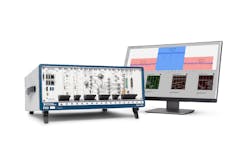An Obstacle Course Ahead for 5G Technology
In December, the 3GPP published the first draft of the 5G New Radio standard. It is an important first step toward 5G communications, but not all carrier equipment following the standard will automatically and consistently link to all smartphones and other devices. It's not that easy.
This is where test equipment companies can flex their muscles. Austin, Texas-based National Instruments recently collaborated with Samsung on interoperability testing, which is critical piece of preparation for 5G. The firm developed test equipment that can be programmed to act like smartphones or other devices and used to test Samsung's commercial 5G base stations.
“With any new standard, there are lots of questions,” said James Kimery, director of wireless research and software-defined radio marketing for National Instruments. “An engineering team takes a 2,500-page document, implements it, and connects to a network first try? That will never happen.”
The wireless industry is going to expunge ambiguous language and other errors from the standard – the Non-Standalone 5G standard, not Standalone 5G – over the next two years. But mistakes could be missed without systems from the likes of National Instruments, Keysight and Rohde & Schwarz to check out commercial base stations.
National Instruments showed Samsung’s 28 GHz base station communicating over the air with its test equipment at Mobile World Congress last month. The device links to the base station and then validates that the downlink functionality and performance are in line with the 3GPP standard. Samsung’s hardware uses a MIMO configuration with two transmit and two receive antennas.
Any changes to the standard would probably affect how devices connect to a network, Kimery said. The physical layer of the standard is probably finished, and that explains why companies like Intel, Qualcomm, Qorvo and Skyworks Solutions have already announced 5G modems and other components for phones.
National Instruments also recently released a 5G reference test solution by updating the software that runs in its PXIe-5840 vector signal transceiver. The VST system provides 1 GHz of instantaneous bandwidth for testing power amplifiers and other parts operating in sub-6 GHz spectrum, the same range of frequencies used in 3G and 4G networks.
Jason White, director of RF wireless test for National Instruments, said that the PXI-based system would help customers make quicker, more precise measurements. Before the 5G standard was published, many companies were guessing how 5G would work. And they had to generate custom waveforms based on these guesses to test 5G parts.
Qorvo used National Instruments’ system to test its first front end module for 5G smartphones, which combines a power amp and low noise amplifier operating at 3.4 GHz into a single package. The companies collaborated on a test demonstration at the Global TD-LTE Initiative Workshop last month.
The biggest challenge for hardware vendors is to balance the wide bandwidth and high efficiency requirements of 5G, White said. There are also test and measurement challenges “because if you are designing a part with 100 MHz of bandwidth, you need a test system with three to five times the bandwidth to test pre-distortion conditions, which is how you measure linearity,” he added.
5G technology will use both low and high frequencies. The 28 GHz spectrum has rarely been used before for communications, so it will have greater capacity than lower bands. But these millimeter waves have more limited uses because they can be blocked by buildings and absorbed by air over long distances.
That has upended how the engineers go about testing, White said. Instead of using emulators to digitally simulate how millimeter waves will propagate through an environment, companies are going right to expensive, over the air tests. It is not clear that an inexpensive emulator for millimeter waves can be built. The technology used to steer them around obstacles is just too complex.
National Instruments says that it has taken steps to lower the cost of testing, but many other challenges stand in the path of widespread 5G. It is significantly more complex than 4G technology, and the switchover to the new standard will not happen overnight in 2020 (when most wireless carriers want to roll out service).
“With every wireless standard, the whole specification doesn’t get implemented on the first try. There is probably not one base station in the world that is compliant with the latest LTE release. I just don’t believe it,” Kimery, the wireless research director for National Instruments, said.
“But we’re going to make it work,” Kimery said. “And when I say we, I mean the collective industry.”
About the Author

James Morra
Senior Editor
James Morra is the senior editor for Electronic Design, covering the semiconductor industry and new technology trends, with a focus on power electronics and power management. He also reports on the business behind electrical engineering, including the electronics supply chain. He joined Electronic Design in 2015 and is based in Chicago, Illinois.
